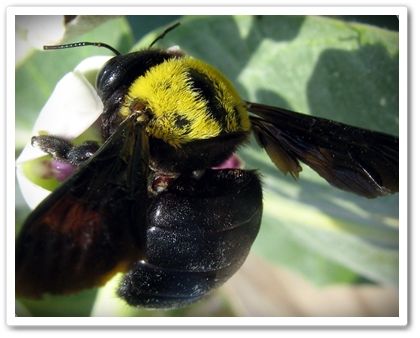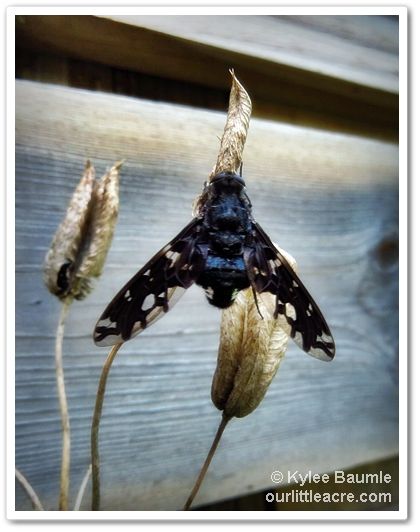 |
| Carpenter bee / Wikimedia Commons |
Carpenter bees (Xylocopa spp.) are solitary bees, meaning they don't live in hives, but rather by themselves, in holes they chew in wood. Some will make nests near a fellow bee and some females even share a nest with another female, however. These bees are not bumblebees, in spite of their looking much like them. Most have a shiny black abdomen, whereas bumblebees have furry ones.
 |
| We have split rail fencing along two sides of our property and they've riddled several rails with their nests. Note the praying mantis underneath the rail! |
Male carpenter bees don't have stingers, so even if I happened to run into one, there's no danger of being stung. The females do sting, but are not aggressive and will only do so if physically threatened by direct contact. They are important pollinators of open-faced flowers, especially the Passiflora genus (Passion flower or maypop).
I'm always interested in the insects, spiders, and other creatures of nature that I come across as I tend to the gardens here at Our Little Acre and yesterday I noticed a big fly hanging around the compost bins. I had my camera with me at the time, so I snapped a photo or two so that I could study it and identify it later.
 |
| Tiger bee fly (Xenox tigrinus) |
It turns out that the fly is a tiger bee fly (Xenox tigrinus). Well, guess what the tiger bee fly does? It lays eggs at the opening of the holes made by carpenter bees. And when those eggs hatch, the larvae feed on the larvae of the carpenter bees. Synergy at work.
Oh, and tiger bee flies don't bite or sting. They don't have biting mouth parts and being a fly, no stinger either.
Carry on, guys.
















 "Bejeweled"
"Bejeweled"



4 comments:
How very interesting! We have lots of carpenter bees around our old deck. They'll be losing their prime housing spot this winter though when we tear it down to build a screened porch. I've never seen these flies those. I'll be watching for them.
We have carpenter bees, too. Haven't noticed a fly like that, but if I see one, now I'll know what it is.
Thanks for the interesting information.
Have a wonderful week!
Lea
Lea's Menagerie
I have carpenter bees around here but I have never noticed the Tiger bee fly. Hmmmm I will have to be on the look out for them.
Great post! I have carpenter bees around, so I'll be on the lookout now for the tiger bee flies. The more I learn about our native bee and fly species, the more fascinated I become.
Post a Comment